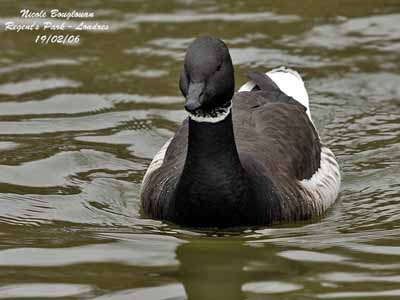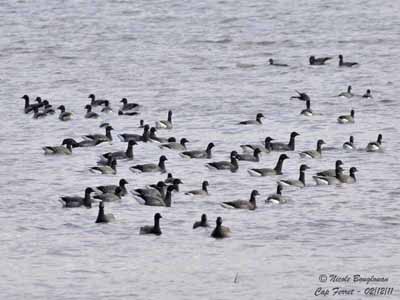
Fr: Bernache cravant
All : Ringelgans
Esp : Barnacla carinegra
Ital: Oca colombaccio
Nd: Rotgans
Sd: Prutgås
Photographers:
Steve Garvie
RAINBIRDER Photo galleries
Tom Grey
Tom Grey's Bird Pictures
Bob Moul
Nature Photography
Peter Moulton
Pete Moulton Photography
Nicole Bouglouan
PHOTOGRAPHIC RAMBLE
Texte de Nicole Bouglouan
Sources:
HANDBOOK OF THE BIRDS OF THE WORLD vol 1 by Josep del Hoyo-Andrew Elliot-Jordi Sargatal - Lynx Edicions - ISBN: 8487334105
THE COMPLETE BOOK OF BRITISH BIRDS – Written by “Royal Society for the Protection of Birds” experts - Préface de Magnus Magnusson - Michael Cady- Rob Hume Editors - ISBN: 0749509112
GUIDE DES CANARDS, DES OIES ET DES CYGNES – de Steve Madge - Delachaux et Niestlé - ISBN: 2603013769
ENCYCLOPEDIE DES OISEAUX DE FRANCE ET D’EUROPE – de Peter Hayman et Rob Hume - Flammarion – ISBN : 2082009920
BirdLife International (BirdLife International)
Birds of Britain - The Web Magazine for Birdwatchers
Brant Goose
Branta bernicla
Anseriforme Order – Anatidae Family
BIOMETRICS :
Length: 55-66 cm
Wingspan: 110-120 cm
Weight: 1200-2200 g
DESCRIPTION:
This “small goose” comes from the northernmost regions of the continents to winter in muddy bays and estuaries in large flocks, forming black patches on the water when they rest close to each other.
The Brant Goose adult has dark brown to blackish plumage. Upperparts are dark grey-brown with fine, weak pale edges. Flight feathers and uppertail-coverts are black.
On the underparts, flanks and belly are dark greyish-brown with pale edges on the upper flanks. Vent, undertail-coverts and rectrices are white, with black outermost tail feathers.

Head, neck and breast are black. We can see an irregular white patch on neck-side, between head and upper neck.
The small bill, legs and webbed feet are black. Eyes are dark brown.
Both sexes are similar.
The juvenile resembles adults, with duller and browner black parts. The white neck patch is absent. Flanks are paler with more conspicuous pale edges forming white barring. Upperparts show white fringes.
It is sexually mature at two-three years.
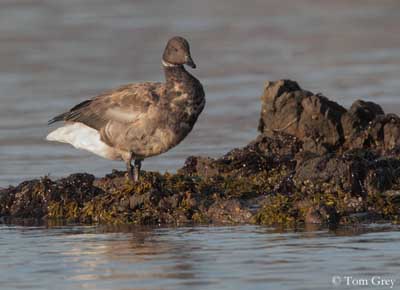

We can find four subspecies:
B.b. bernicla : N & C Siberia and Europe.
B.b. hrota : N Canada, Greenland and Spitzberg.
B.b. nigricans : from extreme NE Siberia to NC Canada.
B.b. orientalis : NE Siberia. This one is usually included in « nigricans ».
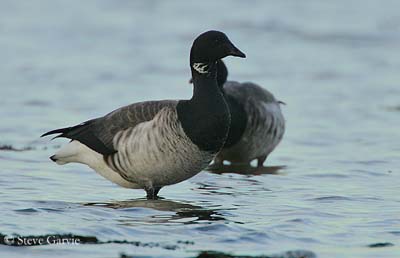
These races differ in side’s coloration.
B.b. hrota is browner on the upperparts, and flanks are pale brown and whitish.
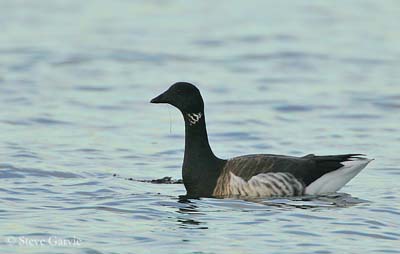
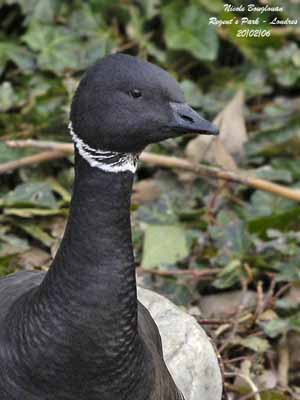
B.b. nigricans is darker than nominate, with very dark belly and fore flanks. The flanks’ feathers show broad white edges contrasting with dark belly. The white neck patches are larger and often join on the fore neck, forming a collar.
VOICE: SOUNDS BY XENO-CANTO
The Brant Goose gives low, guttural, rolling “rronk-rronk” in flight and in feeding flocks. This nasal sound is almost similar to grunts or deep rolling barks, and carries considerable distances.
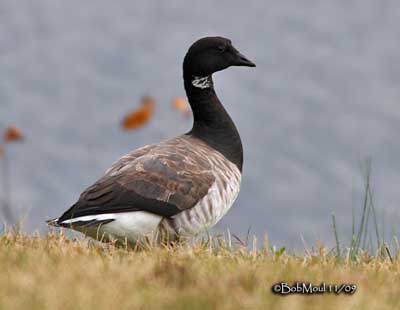
HABITAT:
The Brant Goose breeds in Arctic tundra, farther north than any other species of geese, and usually near coasts, in lagoons and on islands.
This species winters in bays, estuaries, coastal sandy shores and mudflats. It is very rare in freshwater areas.
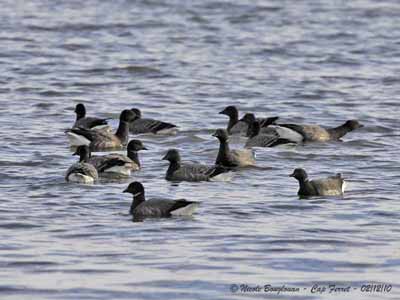
RANGE:
See above in “Subspecies”.
BEHAVIOUR:
The Brant Goose feeds mainly on plant matter. On the breeding grounds, they feed on aquatic plants, mosses, lichens and grasses.
During the winter, the diet includes almost exclusively algae, seaweeds and aquatic vegetation, both in salt and brackish waters. It also grazes on land.
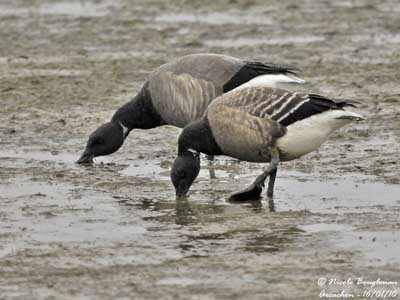

In shallow water, the Brent Goose swims very well and performs upending to reach the vegetation. They feed in large flocks, as well in the water as in coastal meadows along the estuaries.
They roost in tight-packed groups in sheltered bays and coastal water.
In the high latitudes where these geese breed, the good season for the breeding cycle is generally too short, and pair formation and courtship displays often occur in the wintering areas or on migration towards the breeding grounds.
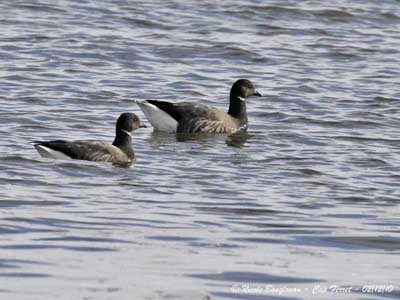
They perform some defence displays, walking with stretched head and neck forwards, in almost horizontal stance, displaying the white neck patches.
They breed once a year during the best period with good weather conditions. The pair usually travels together to the breeding grounds, and remains paired for life.
They nest in colonies, and this behaviour has primarily defensive function against predation by bears, foxes, gulls and skuas.
The displays between two mates involve ritual postures and movements prior to the copulation which usually takes place on the water.
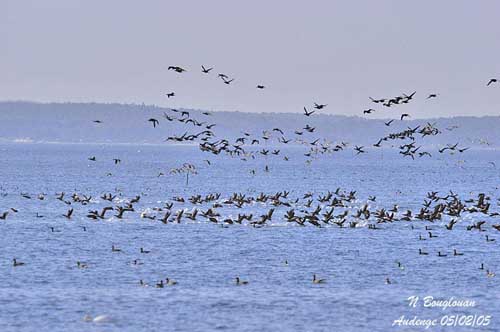
The Brant Goose is migratory. The geese leave the breeding grounds in family groups after the nesting season. They fly in irregular lines or flocks, rarely in typical V formation.
The wintering areas are in NW Europe, E Asia, Atlantic and Pacific coasts of North America.
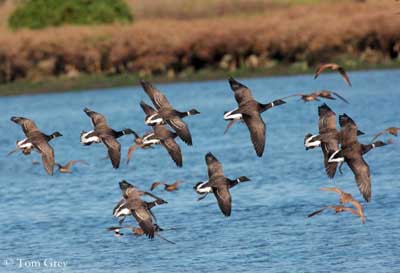
FLIGHT:
The Brant Goose has strong wings and performs fast wing-beats. They fly in compact flock or oblique line, sometimes in well open V formation. During migration, they fly low from the water. During the flight, the white rump is often conspicuous.
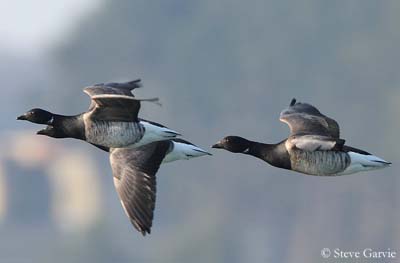
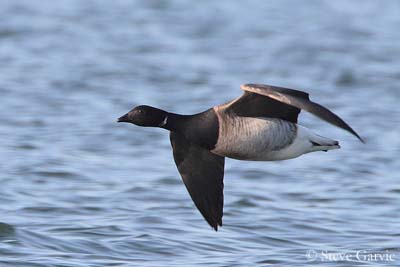
REPRODUCTION:
The breeding season starts in June and lasts about three months.
The Brant Goose nests in solitary pairs or in loose colonies. They nest in the tundra and often close to the water. The nest is a shallow depression in the ground, lined with fine materials such as grass, moss and down.
The female usually lays 3 – 5 eggs in mid-June, and incubates during about 24 - 26 days, while the male remains in the close vicinity during this period. The chicks are covered in greyish down above and whitish below. They leave the nest soon after hatching and fledge in about six weeks, while the adults are moulting.
They remain in family groups until the following breeding period, and migrate together.
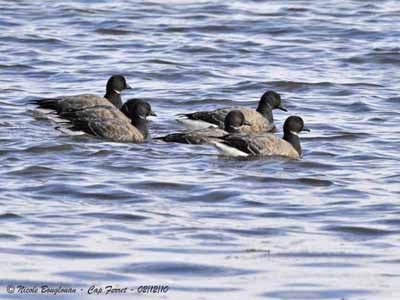
DIET:
The Brant Goose is mainly vegetarian, feeding on grasses, mosses and lichens and aquatic vegetation on the breeding grounds.
During the winter, they feed almost exclusively on aquatic items such as algae, seaweeds and other plants in salt and brackish waters. They also graze on land.
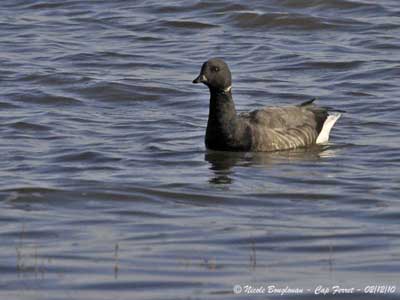
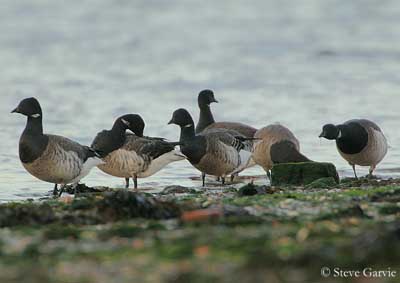
PROTECTION / MENACES / STATUS:
After large declines, the Brant Goose’s populations are relatively stable today. There are important fluctuations between years, according to the variable breeding success depending on conditions on breeding areas, weather conditions, food resources, disturbances and hunting.
However, this species is currently evaluated as Least Concern.

